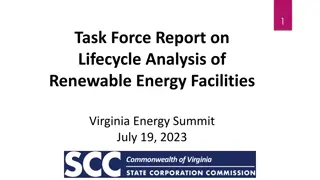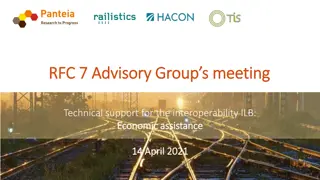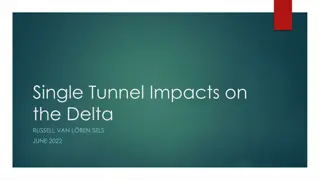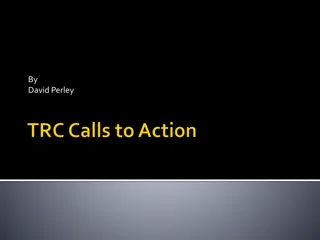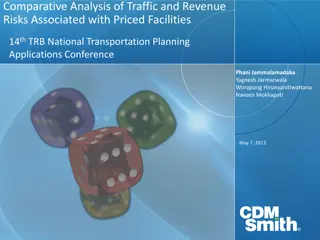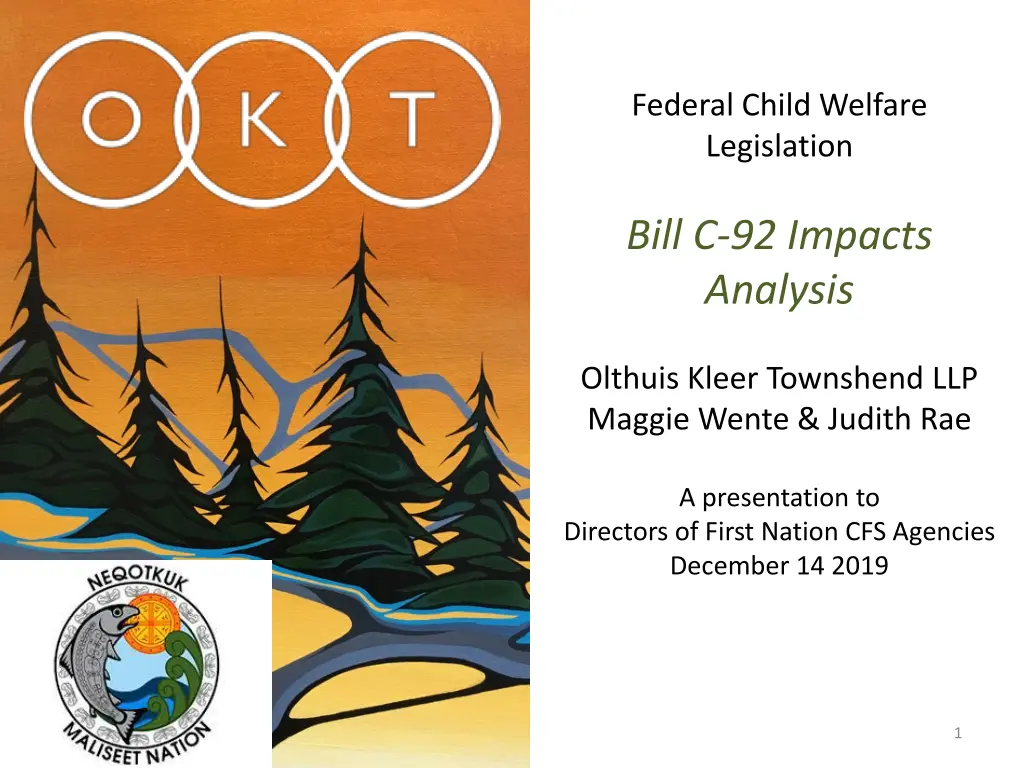
Impact Analysis of Federal Child Welfare Legislation Bill C-92
Explore the implications of Bill C-92 on Indigenous child welfare, including recognition of jurisdiction, minimum standards, and the interaction between Indigenous and provincial laws. Learn how this legislation aims to empower Indigenous communities in Canada.
Download Presentation

Please find below an Image/Link to download the presentation.
The content on the website is provided AS IS for your information and personal use only. It may not be sold, licensed, or shared on other websites without obtaining consent from the author. If you encounter any issues during the download, it is possible that the publisher has removed the file from their server.
You are allowed to download the files provided on this website for personal or commercial use, subject to the condition that they are used lawfully. All files are the property of their respective owners.
The content on the website is provided AS IS for your information and personal use only. It may not be sold, licensed, or shared on other websites without obtaining consent from the author.
E N D
Presentation Transcript
Federal Child Welfare Legislation Bill C-92 Impacts Analysis Olthuis Kleer Townshend LLP Maggie Wente & Judith Rae A presentation to Directors of First Nation CFS Agencies December 14 2019 1
An Act Respecting First Nations, Inuit and Metis children, youth and families Passed into law in June 2019 Not yet in force it will come into force on January 1, 2010 2 Your sovereignty. Your prosperity. Our mission.
What does C-92 do? It does 4 things: 1. It recognizes the UN Declaration on the Rights of Indigenous Peoples 2. It recognizes Indigenous jurisdiction over child welfare 3. It sets out a pathway for the exercise of Indigenous jurisdiction in child and family services 4. It creates minimum standards (rules) that apply over top of provincial child welfare laws, and most of them would also apply over top of Indigenous laws 3
1. Jurisdiction Affirmation 18 (1) The inherent right of self-government recognized and affirmed by section 35 of the Constitution Act, 1982 includes jurisdiction in relation to child and family services, including legislative authority in relation to those services and authority to administer and enforce laws made under that legislative authority. Wolastoqey Jurisdiction is inherent, and it is also recognized by treaties. It has never been extinguished, and therefore it is protected by the Canadian constitution. 4 Your sovereignty. Your prosperity. Our mission.
Jurisdiction What law applies when Once in force: The Indigenous law also has the force of federal law The Indigenous law takes precedence over Provincial law (where there is a coordination agreement) The Indigenous law takes precedence over most federal law, with exceptions (these prevail over the Indigenous law): o ss. 10-15 of C-92: the minimum standards o s. 23 of C-92: a general best interests override clause (very odd) o Human rights (Charter & Canadian Human Rights Act) o If there is no coordination agreement 5 Your sovereignty. Your prosperity. Our mission.
How is it supposed to work? C92 in PHASE 1 C92 in PHASE 2 CURRENTLY Federal Laws in C-92 Federal Laws in C-92 only Provincial/ Territorial Laws were applied C-92 Indigenous Laws Provincial/Territ orial Laws Provincial/ Territorial Laws 6 Your sovereignty. Your prosperity. Our mission.
Jurisdiction Pathways 2 Roads Two possible pathways to jurisdiction: (1) One pathway leads to paramountcy over provincial laws (2) One pathway involves no paramountcy over provincial law, and therefore does not have the force of federal law Strong incentive to pursue paramountcy option 7 Your sovereignty. Your prosperity. Our mission.
2. Jurisdiction Pathways to Paramountcy There s a process to exercise it: Give notice to Canada and Province(s) 1 Make reasonable efforts to negotiate a Coordination Agreement (including funding) 2 Can come into force after a Coordination Agreement is made, or after 1 year, without an agreement, if reasonable efforts were made, law will be published 3 8 Your sovereignty. Your prosperity. Our mission.
2. Jurisdiction Pathway No Paramountcy There s a process to exercise it: Give notice to Canada and Province 1 No requirement for coordination agreement, but if you don t try.. 2 Can come into force but will not be paramount over provincial laws 3 9 Your sovereignty. Your prosperity. Our mission.
Jurisdiction Pathway Coordination Agreements could include: Fiscal arrangement for the provisions of the programs and services that are substantive, needs- based, and consistent with the principle of substantive equality Can include other topics relating to coordination of services with federal and provincial governments 10 Your sovereignty. Your prosperity. Our mission.
3. Minimum Standards The way it works is a concurrent jurisdiction model. The Act layers on top of Provincial and Indigenous laws. Both or all three apply, unless there s a conflict or inconsistency . Some First Nations in Canada support having federal standards, especially over Provincial law. But the value this provides in Ontario is low. Other FNs may object to any federal standards at all, especially over Indigenous laws. Sections 10-15 will apply no matter whose law is in force. 11 Your sovereignty. Your prosperity. Our mission.
3. Minimum Standards Sections 10-17 of C-92 have substantive content about child and family services, for instance: S. 10 lists 8 factors that should be taken into account when considering an Indigenous child s best interests Includes cultural, linguistic, religious and spiritual upbringing; relationship with parents; importance of preserving cultural identity 12 Your sovereignty. Your prosperity. Our mission.
Minimum Standards S. 11 is about effects of services requiring that services be provided in ways that meet children s needs, security, take into account culture, ensures the child knows the family, and promotes equality S. 12 sets out requirements for child and family service providers to provide notice to the child s parents and care providers and the Indigenous government, and sets some limits about sharing personal information 13 Your sovereignty. Your prosperity. Our mission.
Minimum Standards Section 13 provides that a parent and care provider and an Indigenous government have the right to make representations in court. Parents and care providers are parties in court. Section 14 places a priority on prevention over apprehension, and for service providers to make reasonable efforts to provide prenatal prevention services over apprehension at birth (this is theoretically supposed to end birth alerts) 14 Your sovereignty. Your prosperity. Our mission.
Minimum Standards Section 15 provides that as long as it is in the child s best interests, children should not be apprehended solely for reasons of poverty, lack of adequate housing or infrastructure, or state of health of parents or caregivers Section 15.1 provides that the service provider must make reasonable efforts to have the child reside with their parent or caregiver before apprehension 15 Your sovereignty. Your prosperity. Our mission.
Minimum Standards -section 16 provides that there is a priority of placement for children (as long as it is consistent with best interests) for: parents, family, same Indigenous community/group/people, others. Section 16(2) says that placement with or near siblings must be considered . Section 16(3) says that there must be a reassessment of placement on an ongoing basis, to see if the child can be returned to their parents or extended family. 16 Your sovereignty. Your prosperity. Our mission.
Minimum Standards Section 17 says that a child s attachments and emotional ties to members of family should be promoted if the child is not placed with family 17 Your sovereignty. Your prosperity. Our mission.
What law prevails if theres a conflict or inconsistency between laws? Charter of Rights and Freedoms Other constitutional law including section 35 (section 35 s role here is complex) Federal Rules in Federal Child Welfare Act: ss. 10-15 Canadian Human Rights Act A child s best interest (section 23) Indigenous Law (if recognized pursuant to Federal Child Welfare Act) Federal Rules in Federal Child Welfare Act: ss. 16-17 and generally Other federal laws (if any are relevant) Provincial or Territorial Law 18 Your sovereignty. Your prosperity. Our mission.
What are the opportunities? Opportunity for you to decide what happens to your children and how your children are treated when their families need help Flexibility to decide what parts of child welfare services you want to control, and when, while overriding provincial laws Decide to have a child welfare system that looks nothing like settler systems Opportunity to administer your own child welfare law this is an opportunity for a court, a Grandmothers Council or other decision making body or bodies to decide what happens to your children 19 Your sovereignty. Your prosperity. Our mission.
Recognition of Wolastoqey Law by statute: Compromise? There are some limits that some find offensive to inherent jurisdiction and sovereignty: The fact of Federal legislation recognizing Wolastoqey inherent jurisdiction The fact that it makes a Wolastoqey law also having the force of federal law The fact that there are limits imposed on the absolute exercise of jurisdiction Some object that a system by recognition still places Indigenous laws as subordinate to Canadian laws; this isn t try sovereignty 20 Your sovereignty. Your prosperity. Our mission.
Funding: The Elephant in the Room The Act only mentions funding in passing (in the Preamble, and as a topic for negotiation). It does not commit the federal government to provide fair funding at the standard of substantive equality, the legal standard confirmed by the Canadian Human Rights Tribunal (CHRT). Substantive equality means: - Meets needs, and addresses differences (e.g. remoteness) - Culturally appropriate - Addresses historical disadvantage - Ensures comparable quality and service levels 21 Your sovereignty. Your prosperity. Our mission.
Red Flags Laws can be made by any Indigenous group, community or people what does that include? Who is the rightsholder? Unclear scope of child and family services and other terms Risk of uncertainty in the implementation of multiple laws Questions on enforcement No funding commitments announced yet to support development of Indigenous laws, or to support negotiation of Coordination Agreements The law is not drafted perfectly and First Nations laws will be extremely technical and complicated to draft 22 Your sovereignty. Your prosperity. Our mission.
Liability and Appeals Liability There are potential avenues for liability that you want to consider when assuming jurisdiction Settler governments all shield themselves from certain kinds of liability through legislation. You will want to ensure you have adopted similar rules to insulate yourself as governments Similarly, you will want the decision-makers under your legislation to be absolved of liability the way judges are under the common law Appeals You may want to, as much as possible, insulate Canadian courts from reviewing decisions under your laws. You will want to be specific about how appeals and judicial reviews are handled 23 Your sovereignty. Your prosperity. Our mission.
Opportunities to be taken right now? There is opportunity to take right now before your full child welfare law is developed Clarify some of the gaps or vague terms in the federal legislation that are in the standards E.g., what are reasonable efforts ; what are stronger ties Establish some additional rules on child and family services for now (that you can fund yourselves, that don t require paramountcy) You don t necessarily need a coordination agreement for these 24 Your sovereignty. Your prosperity. Our mission.
Longer Term Opportunities for Communities The Act doesn t provide an unencumbered jurisdictional model that is, it still impedes First Nations jurisdiction, and sometimes significantly However, the Act could be a tool to change and override some of the undesirable features of Canadian (provincial) child welfare laws Funding will be a major barrier 25 Your sovereignty. Your prosperity. Our mission.
Longer-Term Opportunities for Communities The jurisdiction recognized in the legislation could include jurisdiction to the administration of a court or dispute resolution system -- this is extremely powerful as you could set up tribal courts to take decision making out of the hands of Canadian courts It is likely that many communities will not be able to move to an entirely First Nations-run child and family services regime and justice system right away, but incremental change is possible under this legislation 26 Your sovereignty. Your prosperity. Our mission.
Chi - Miigwetch! Maggie Wente 416-981-9340 mwente@oktlaw.com jrae@oktlaw.com www.oktlaw.com Judith Rae 416-981-9407 27












